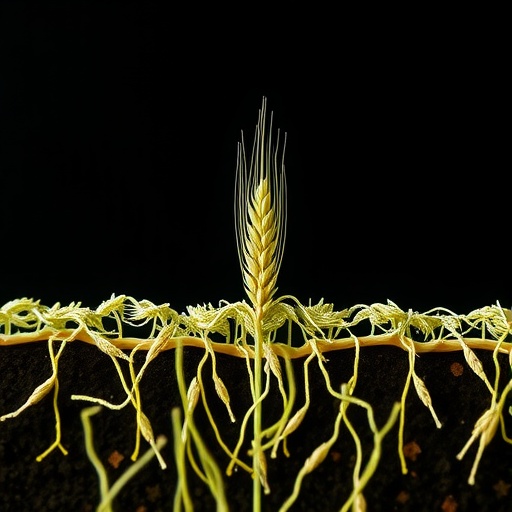In the quest to unlock new dimensions of agricultural microbiology, a groundbreaking study recently published in Nature Microbiology reveals the pivotal role of seed-borne bacteria in shaping the wheat rhizosphere microbiome. The research delivered by Garrido-Sanz and Keel uncovers the sophisticated ecological dynamics governing microbial community assembly at the soil-root interface, highlighting niche partitioning and facilitation as central mechanisms that determine the organization and functionality of this critical plant microbiome. This discovery not only rewrites fundamental understandings of plant-microbe interactions but also opens pathways for innovative strategies to enhance crop health and sustainability in a rapidly changing climate.
Wheat, as one of the world’s staple cereals, sustains billions, yet its growth is continuously challenged by environmental stressors, pathogens, and soil nutrient deficiencies. The rhizosphere—the narrow zone of soil surrounding roots—is a hotspot for microbial activity and interactions that profoundly affect plant vigor by regulating nutrient uptake, pathogen resistance, and stress tolerance. Despite extensive studies on rhizosphere microbiomes, the origin and assembly of these microbial communities remain enigmatic, with previous emphasis largely placed on soil microbial populations. The recent study shifts focus onto seed-borne communities, revealing that seeds act as initial carriers of key bacterial taxa that actively steer rhizosphere community formation and function from the earliest developmental stages.
In addition to niche partitioning, the study highlights facilitation, an ecological process where certain microbes modify the environment in ways that benefit other community members. Seed-borne bacteria were found to secrete metabolites and modulate root exudate profiles, thereby creating favorable conditions for secondary colonizers. This facilitative interaction cascade not only enriches the functional repertoire of the rhizosphere microbiome but also contributes to its resilience against biotic and abiotic stressors. The emergent network of mutualistic relationships underscores the sophistication of microbial interactions and their integrated role in plant health.
Methodologically, the study exemplifies state-of-the-art approaches by combining culture-independent metagenomics with culture-based isolation and functional assays. High-resolution sequencing enabled the reconstruction of bacterial community composition dynamically from seed to rhizosphere during wheat growth cycles under controlled and field conditions. Coupled with transcriptomics and metabolomics, these techniques provided a multi-layered perspective of microbial activity and host-microbe dialogue. This comprehensive toolkit allowed the authors to track the fate of seed-borne bacteria precisely and dissect their ecological roles within the rhizosphere milieu.
From a practical standpoint, the findings have profound implications for sustainable agriculture. Harnessing seed-borne bacterial consortia offers a promising avenue for bioinoculants development that primes the wheat microbiome from germination onward. By selectively augmenting beneficial taxa involved in nutrient mobilization and pathogen suppression, seed treatments could reduce dependency on chemical fertilizers and pesticides, thereby promoting environmentally friendly crop management. Moreover, understanding facilitation networks provides a blueprint for constructing synthetic microbial communities tailored to boost plant resilience and yield under adverse environmental conditions.
The research also challenges existing paradigms about microbial biogeography in the rhizosphere. It suggests a sequential assembly model whereby microbial colonization and succession begin with seed transmission and are modulated by root exudates and soil physicochemical gradients. This temporal dynamic demarcates a critical window during early plant development when interventions targeting seed microbiota could have long-lasting impacts on rhizosphere ecology and plant performance. Future research might explore the variability of seed microbiomes across wheat cultivars and environmental contexts to optimize these early microbial interventions.
Ecologically, the discovery emphasizes the importance of vertical microbial transmission—where bacteria pass from parent plants to seeds and subsequently into the soil environment. This vertical transmission is akin to inherited microbiomes in animals and hints at co-evolutionary relationships between wheat plants and their seed-associated microbiota. Such evolutionary perspectives could reshape breeding programs to consider microbiome traits as selection criteria, integrating plant genetics with microbial ecology to develop ‘microbiome-assisted’ cultivars tailored for future agricultural challenges.
The study also sheds light on the chemical language that mediates plant-microbe and microbe-microbe interactions. By characterizing bacterial metabolites and their modulation of root exudation, Garrido-Sanz and Keel provide clues about molecular dialogues that govern community assembly. These chemical signals act as attractants, growth regulators, or antibiosis agents, orchestrating a balanced rhizosphere environment. Deciphering this biochemical code could unlock new bioengineering avenues to manipulate microbial consortia for improved plant productivity.
In terms of environmental impact, promoting natural microbial assemblages through seed-borne bacteria potentially enhances soil health by stimulating organic matter decomposition, soil aggregation, and nitrogen fixation. This biological approach to managing soil fertility aligns with global efforts to mitigate environmental degradation from intensive agriculture and reduce greenhouse gas emissions associated with agrochemicals. The study’s insights reaffirm the concept of the rhizosphere as a complex ecosystem, where leveraging native biological processes offers a sustainable path forward.
From a technological perspective, the integration of multi-omics with computational modeling in this study sets a benchmark for investigating microbial ecology at unprecedented resolution. Systems biology approaches allowed the authors to simulate community interactions and predict microbiome responses to environmental variables. These predictive frameworks are crucial for transitioning from descriptive studies to actionable knowledge, enabling precision microbiome engineering and tailored agronomic practices in the face of climate variability.
The broader implications of this research extend into food security, ecosystem services, and agricultural policy. By leveraging the intrinsic potential of seed-borne bacteria to optimize rhizosphere function, interventions can enhance crop efficiency while safeguarding biodiversity and soil ecosystems. Policymakers and stakeholders in agriculture might consider promoting seed microbiome research and applications as integral components of sustainable intensification and resilience-building strategies in global food systems.
Subject of Research: The ecological roles of seed-borne bacteria in the assembly and function of the wheat rhizosphere microbiome through mechanisms of niche partitioning and facilitation.
Article Title: Seed-borne bacteria drive wheat rhizosphere microbiome assembly via niche partitioning and facilitation.
Article References:
Garrido-Sanz, D., Keel, C. Seed-borne bacteria drive wheat rhizosphere microbiome assembly via niche partitioning and facilitation. Nat Microbiol (2025). https://doi.org/10.1038/s41564-025-01973-1
Image Credits: AI Generated
Tags: agricultural sustainability and climate changebacterial taxa in wheat seedsecological dynamics of rhizosphereenhancing crop health through microbiomesmicrobial community ecology in soilniche partitioning in plant rootsplant-microbe interactionsrhizosphere microbiome assemblyseed-borne bacteria in agriculturesoil-root interface microbial interactionswheat cultivation and environmental stressorswheat root microbiome dynamics





